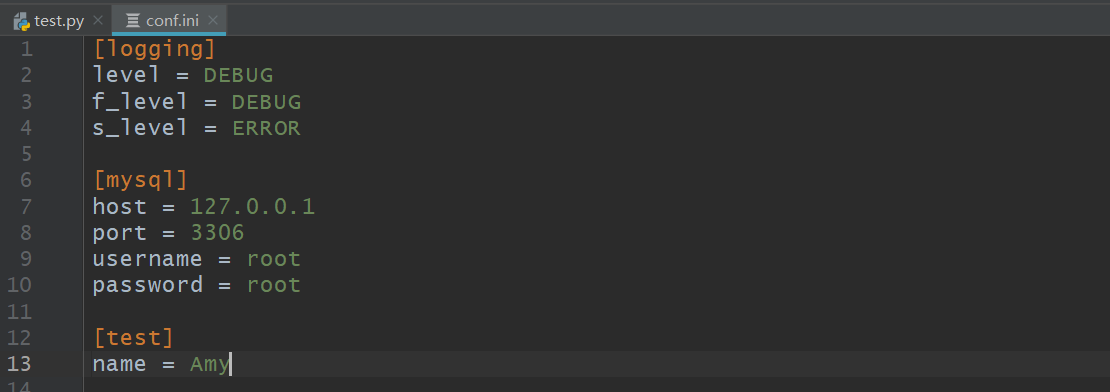前言:目前我们使用的绝大多数计算机程序,无论是办公软件,浏览器,甚至游戏、视频都是通过菜单界面系统配置的,它几乎成了我们使用机器的默认方式。而在python中,也有这样的一个配置模块可以把代码可配置化。
什么是配置文件
这里的配置文件不同于我们平常所见的可视化的菜单界面,它是像代码形式的,如下示例:

为什么要做配置文件?
让代码和配置都变成可模块化可配置化,提高代码的重用性,那什么时候把它变成可配置化呢?多处地方都用到一个参数时,经常会变化的参数等,都可以可配置化,我们只需要在配置文件中进行修改即可,不需要在代码中一处处的重复修改。
Python提供了一个ConfigParser模块,它实现了一种基本的配置文件解析器语言,该语言提供的结构类似于.ini文件中的结构。常见的配置文件格式有.ini.conf.cfg,配置文件由两个文件对象组成:section和option,一个配置文件里可以包含一个或多个节(section),每个节可以有多个option(键=值),如上图所标示。
读取配置文件
它与file文件一样,需要先打开才能进行读取操作,常用方法如下:
-
read(filename):直接读取配置文件内容 -
sections():以列表的形式返回所有section -
options(section):得到对应section下的所有option -
items(section):得到对应section下的所有键值对 -
get(section,option):得到对应的section中的option的值,并以string的类型返回 -
getint(section,option):得到对应的section中的option的值,并以int的类型返回
以上图中的conf.ini为例进行读取操作:
|
1
2
3
4
5
6
7
8
9
10
11
12
13
14
15
16
17
18
19
20
21
22
|
from configparser import ConfigParser# 创建一个操作配置文件的对象(文件解析对象)conf = ConfigParser()# 读取配置文件conf.read("conf.ini", encoding="utf8")# 获取所有sectionres2 = conf.sections()print("这是res2:{}\n".format(res2))# 获取对应section下的optionres3 = conf.options("logging")print("这是res3:{}\n".format(res3))# 获取对应section下的所有键值对res4 = conf.items("logging")print("这是res4:{}\n".format(res4))# get方法:读取出来的内容,都是字符串res5 = conf.get("logging", "level")print("这是res5:{}".format(res5), type(res5))# getint方法:读取出来的内容,都是int类型res6 = conf.getint("mysql", "port")print("\n这是res6:{}".format(res6), type(res6)) |
运行结果:
C:\software\python\python.exe D:/learn/test.py
这是res2:['logging', 'mysql']这是res3:['level', 'f_level', 's_level']
这是res4:[('level', 'DEBUG'), ('f_level', 'DEBUG'), ('s_level', 'ERROR')]
这是res5:DEBUG <class 'str'>
这是res6:3306 <class 'int'>
Process finished with exit code 0
除了可以读取str、int类型以外,还支持float、boolean,这里就不再举例。
小知识:
-
键值对可用
=也可用:进行分隔 -
section名称是区分大小写的,而option不区分 - 键值对中,首尾若有空白符会被去掉
-
配置文件中也可以写入注释,注释以
#或者;为前缀
写入配置文件
基本的写入方法如下:
add_section(section) :添加一个新的sectionset( section, option, value) :对section中的option进行设置,需要调用write将内容写入配置文件
|
1
2
3
4
5
6
7
|
from configparser import ConfigParser# 创建一个操作配置文件的对象(文件解析对象)conf = ConfigParser()conf.add_section('test')conf.set('test', 'name', 'Amy')conf.write(open('conf.ini', "a", encoding="utf-8")) |
运行后查看conf.ini文件里面的内容:

ConfigParser的封装
一次封装,一劳永逸,之后直接调用即可,封装内容按需。
|
1
2
3
4
5
6
7
8
9
10
11
12
13
14
15
16
17
18
19
20
21
22
23
24
25
26
27
28
29
|
from configparser import ConfigParserclass MyConf: def __init__(self, filename, encoding="utf8"): self.filename = filename self.encoding = encoding self.conf = ConfigParser() self.conf.read(filename, encoding) def get_str(self, section, option): return self.conf.get(section, option) def get_int(self, section, option): return self.conf.getint(section, option) def get_float(self, section, option): return self.conf.getfloat(section, option) def get_bool(self, section, option): def write_data(self, section, option, value): self.conf.set(section, option, value) self.conf.write(open(self.filename, "a", encoding=self.encoding)) if __name__ == '__main__': print(conf.get_str("conf.ini", "test","name")) # 测试 |
总结
到此这篇关于python接口自动化 ConfigParser配置文件的使用的文章就介绍到这了,更多相关python接口自动化ConfigParser配置文件内容请搜索服务器之家以前的文章或继续浏览下面的相关文章希望大家以后多多支持服务器之家!
原文链接:https://www.cnblogs.com/miki-peng/p/13419730.html













